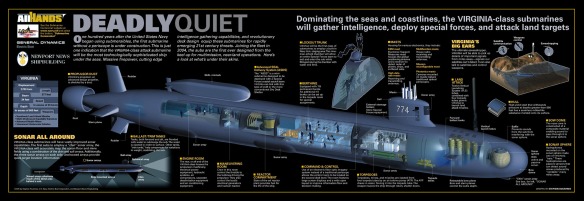This class was designed to be a slightly cheaper alternative to the Seawolf type, whose cost overruns had caused consternation within the navy and Congress. Principal savings were expected to arise from the greatest possible use of ‘off- the- shelf’ electronics, but the type still proved more expensive than the Seawolf class. Congressional and naval concern that the United States might soon be reduced to a single yard capable of constructing submarines led to the decision to build these boats at both the Newport News and Electric Boat yards. The Newport News facility builds the stern, habitability and machinery spaces, torpedo room, sail, and bow, while Electric Boat builds the engine room and control room. The two yards alternate work on the reactor plant as well as the final assembly, test, outfit and delivery. Contracts have been let for eight boats so far, with orders anticipated for one additional boat in 2007 and 2008, and ultimate plans for building 24 submarines of this type with delivery on an annual basis.
With the end of the Cold War in the early 1990s, and the Navy’s changing emphasis to littoral (shallow water) operations, came the development of the new Virginia class fast attack boat, a smaller and less expensive replacement for the aging Los Angeles class attack subs. A redefined requirement called for an advanced, multi-mission nuclear-powered submarine highly capable in both deep ocean anti-submarine warfare and littoral operational environments.
To reduce the acquisition and life-cycle costs of the Virginia class design and engineering process, a whole range of state-of-the-art methods are being employed. These include concurrent engineering design/build teams, computer-aided design and electronic visualization tools, system simplification, parts standardization and component elimination. These innovations help to keep the new submarine affordable in sufficient numbers to meet the Navy’s future nuclear attack submarine force level need.
Electric Boat Division of General Dynamics in Connecticut is the lead design authority for the Virginia class and is the builder of the first boat of the class, the Virginia, SSN 774, at Newport News, Virginia, and commissioned in 2004. The Navy’s total requirement for the Virginia class is thirty submarines.
The Virginia class submarine is similar in size to her Los Angeles class predecessor, at 377 feet long and a thirty-four-foot beam, but her submerged displacement is greater at 7,800 tons. She is fast (twenty-eight knots submerged) and has a published depth of 800+ feet. She comes with four twenty-one-inch torpedo tubes and twelve vertical launch system tubes for Tomahawk cruise missiles. She can also deliver advanced mobile mines and unmanned undersea vehicles. Her command center is installed as one single unit which rests on cushioned mounting points. Her control suite is equipped with computer touch screens and her steering and diving control is via a four-button two-axis joystick.
The Virginia class sub features an Advanced Swimmer Delivery Vehicle which is a mini-submarine atop the hull for delivering special warfare forces such as SEAL teams or Marine reconnaissance units for counter-terrorism or localized conflict operations. At sixty-five feet in length, the ASDV is nearly twelve feet longer than the Holland, the U.S. Navy’s first submarine.
Acoustically, Virginia has a lower noise level than that of the Russian Improved Akula class and fourth-generation attack submarines. This is achieved through the use of a newly designed anechoic coating, isolated deck structures, and a new-design propulsor. Without a traditional bladed propeller, the Virginias use pump-jet propulsors, originally developed for the Royal Navy’s Swiftsure submarines. Propulsors significantly reduce the risks of cavitation and allow quieter operation.
The Command, Control, Communications and Intelligence system of the Virginia integrates all of the boat systems (sensors, navigation, weapon control and counter-measures). The vertical launch system is capable of firing sixteen Tomahawk cruise missiles in a single salvo. A 3,500-pound Tomahawk can deliver 1,000 pounds of high explosive within inches of its target over a distance of 1,500 miles. Capacity for twenty-six Mk 48 heavyweight ADCAP torpedoes and Sub Harpoon anti-ship missiles is provided. The Mk 48 can bring 650 pounds of high explosive a distance of more than five miles. Mk 60 CAPTOR mines may also be carried.
Virginia class sensors include bow-mounted active and passive array, wide aperture passive array on flank, high-frequency active arrays on keel and fin, and towed arrays. Her propulsion unit is the General Electric Pressure Water Reactor S9G which is designed to last as long as the submarine itself, two turbine engines with one shaft and a pump-jet propulsor. The reactor will not need refuelling during the entire lifetime of the boat.
Operated by a crew of 113 officers and men, according to the U.S. Navy Virginia’s performance surpasses that of any current projected threat submarine, ensuring U.S. undersea dominance well into the century.
